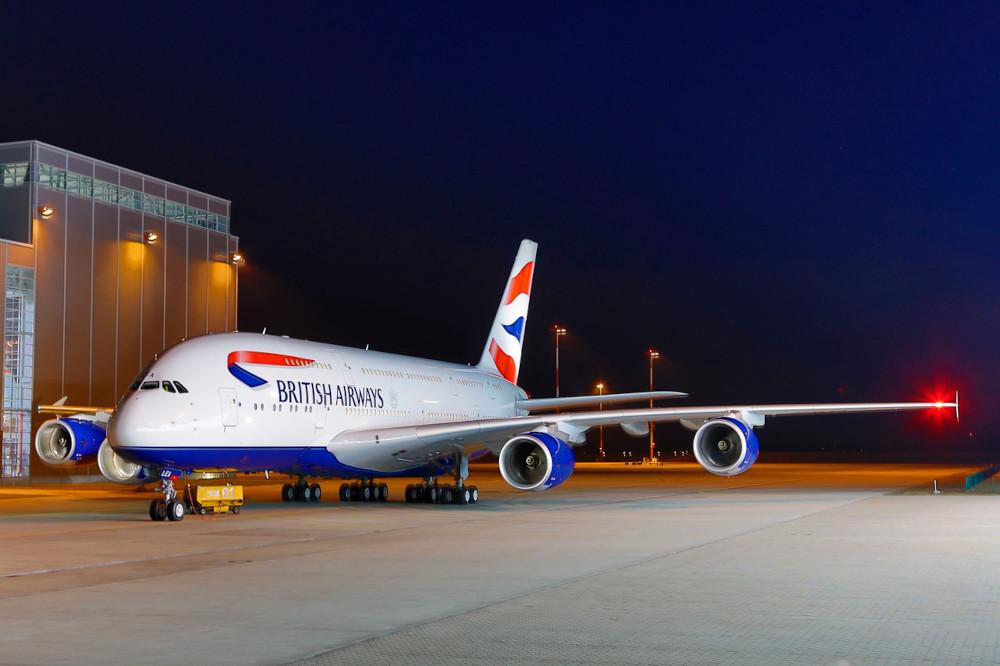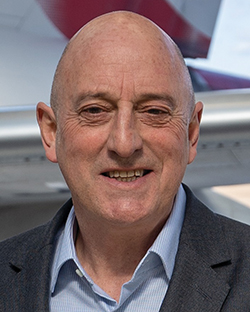
British Airways operates a fleet of 12 Airbus A380 aircraft.
Andy Best, chief technical officer at British Airways, talked with James Pozzi at MRO Europe in Amsterdam in October about how the airline is transforming from an operational perspective and how it is strategizing recruitment and sustainability targets.
What are some of the key operational transformations British Airways has made within its maintenance division since you joined as chief technical officer in April?
British Airways is transforming as an airline since coming out of the pandemic. The fleet has transitioned over the past few years. Our Boeing 747 aircraft have been retired, we have moved on to operating Airbus A350s, 787s, and the 777-9 is coming into the widebody fleet. These fleet changes not only help differentiate us in the market but also enable us to better deliver our product to the customer. Inside the cabin itself is where some of the main changes on the engineering side are taking place. The whole structure of the cabin layout has changed, and the installation of new seating in the First and Club World areas of our aircraft really is a game changer.
In engineering, we’ve introduced the ChronicX and Aviatar platforms into our operational systems. These have allowed us to plan far more in our approach to engineering. We’ve targeted where we use our touch time on the aircraft because with the fleet size that British Airways operates, we must make sure every available touch time is maximized.
The five pillars of transformation I launched for engineering on arrival are: operational excellence, material and supply chain, cabin standards, recruit and retain and the right cost. Focusing on the area of operational excellence, we used ChronicX and Aviatar to make sure we are driving the highest levels of fleet health. It’s about identifying defects before they even come in and making sure that we’re allocating the labor, downtime material and tooling in line, base and heavy maintenance activities. All that flow and transition that we’re doing from engineering into the cabin and the fleet is about driving change into the wider British Airways operation.
What does British Airways look for in an MRO partner?
We like to contract with a provider and work with them as a real partnership. It is important to work closely with partners because we both need to succeed while delivering. It’s important that the risks we identify in partnerships are on the table at the start and are mitigated by the actions we both take. We expect our providers to be agile in their approach. I want them all to be challenging the norm: What we do today isn’t necessarily good enough for tomorrow. We need to improve in everything we do daily, and this is what we also expect from our partners. Also, partners must have a sustainability plan. This needs to meet British Airways’ aims, and if they don’t, it will be difficult to work with us.
Where is British Airways seeing challenges in the global MRO supply chain?
It’s not a lot different to what many airlines are experiencing, but we are only looking forward now. We contract a lot of services to OEMs and large providers, all of whom are experiencing the same struggles as us. The ability of these big providers to recover needs to step up, and there needs to be a significant shift in gears in terms of how they approach this recovery. There must be a clear understanding from the side of OEMs or large providers about the impact they have on the airline operation and ultimately on the customer. We have flight-hour agreements covering all our aircraft, and even though there’s been a significant improvement on those flight-hour agreements, we are still a number of percentage points below what the contract rates would say. That amount of differentiation in delivery just means an amount of risk, and that is transferred to us and our customers—the OEMs and the providers don’t feel it. Encouragingly, having met with some major OEMs recently, they’ve stepped up and done a lot of work and investment in improvements. This will start to come through eventually, but they need to continue being proactive.

How has British Airways mitigated some of these supply chain challenges?
A lot of it is down to cost. We’ve hired and invested more in contract oversight, which gives us far more stringent control. While this isn’t ideal, it is a necessity. We’ve invested in more stockholding to mitigate the supply chain lines. Since Brexit, issues are popping up daily, stopping things arriving at Heathrow Airport. We’ve also started to look at what we need to do in-house, which to be honest, I don’t want to do, but when it has started impacting the airline’s operational support, we’ve had to act.
For cost drivers in the engine world, we’ve had to look at mitigating the turn times of those engines, which has included even investing in some engines to support certain areas. There is a need to drive turn times back to what they were pre-pandemic. We understand there’s raw material issues in the supply chain and other challenges for OEMs in that area. But we need to manage that with the OEMs and MROs that do our engine shop work so this doesn’t impact the engines we have available to maintain our fleet. We cannot push maintenance to the side and end up with a bubble—meaning the risk is passed back to us. It must be dealt with in a better way.
What are some of British Airways’ plans for maintenance recruitment?
Coming out of the COVID-19 pandemic, when a lot of people left the industry, resulted in a hiring drive across British Airways, with more than 10,000 people joining the airline. While this is great that we can recruit in these numbers, it also brings challenges. In engineering, the focus is: What do we need to get recruitment-wise by the end of 2024? We need a lot of people, and it’s not all about licensed engineers, although that is a challenge. Since the separation of the UK from the European Union, that has brought another boundary that is difficult to overcome in recruitment. This means we must take control of our own destiny. We recruit a number of colleagues through our apprenticeship scheme, which I’m very happy with, and we will continue to grow that. We’ve also looked at adjacent industries, such as rail and automotive, while exploring military pathways into the airline, not just in technical roles but other ones across the business.
How is British Airways factoring diversity and inclusion targets into its recruitment?
It’s inherent in British Airways and integral to what we do. However, we recognize we have more work to do. This isn’t just in terms of diversity of genders or ethnicity but also in the recruitment of people with additional needs. We want to make sure that everybody feels and sees that they have an opportunity with us and that everybody can apply for a role that they feel they can bring value to. This isn’t about British Airways choosing people but more about people choosing British Airways, and we need to position ourselves. We need to present a clear path for people to join in the wider context of British Airways by letting people know about the career opportunities not just in the airline but also across the wider International Airline Group, whether that be in Ireland, Spain or another part of the world. I’m an example of this, having started in Iberia and moved across to British Airways. We need to make sure that the opportunities across International Airline Group can differentiate us from other airlines in the market. We want to make sure that people see, in every aspect, that they can bring value to a position. This approach needs to come from the top of the organization with the business living and breathing this.
How are you implementing sustainability initiatives across the airline?
We are committed as an airline to achieving net-zero emission by 2050. Sustainability is embedded in what we do. The way we’ll reach those targets is through the fleet transition and moving toward new fuel-efficient aircraft. Sustainable aviation fuels [SAF] will also be a big driver toward this, but there must be some significant moves in SAF production in the UK to help us achieve that. Operational efficiency and behaviors—such as single-engine taxis, auxiliary power unit usage and flight planning—are also important contributors. We’ve replicated what we did at Iberia by installing solar panels across the top of some of our bigger hangars. For example, the aim of our Cardiff facility is to be energy self-sufficient in five years. In recycling, even if it’s glass tubes here or metal there, every little bit helps us achieve that net-zero 2050 target. The key to that is making sure everybody understands their role in the transition.
British Airways Fact File
Headquarters: London
History: Although its origins date back to 1919, British Airways as an entity was formed in 1974 following the merger of four UK airlines, including British Overseas Airways Corp. and British European Airways, along with two smaller regional airlines, Cambrian Airways and Northeast Airlines. In 1976, British Airways began operating the Concorde supersonic aircraft, which continued up the aircraft was retired in 2003. Initially state-operated, the airline was privatized in 1987 and has grown over the decades through acquisitions of British Caledonian in 1987, Dan-Air in 1992 and British Midland International in 2012. It merged with Spanish airline Iberia in 2011, leading to the creation of International Airlines Group, which also includes Irish flag carrier Aer Lingus and Spanish low-cost airline Vueling. In 2019, British Airways flew about 47 million passengers during the calendar year. That number dropped sharply the following year due to the pandemic, resulting in fleet changes such as the retirement of its remaining Boeing 747 aircraft. The airline’s recovery picked up pace in 2022, when it served about 33 million passengers.
Fleet: British Airways’ main fleet, excluding its BA CityFlyer and BA EuroFlyer subsidiaries, numbered 242 aircraft as of September 2023. The fleet comprises a mix of current- and new-generation Boeing and Airbus aircraft. The carrier operates A320 classic and Neo variants, 16 A350-1000s (of which it is the largest European operator) and 12 A380-800 aircraft. Its Boeing fleet consists of 777-200ER and -300ER variants; the newer 777-9 is expected to start joining the fleet in a few years. British Airways also flies more than 30 787 aircraft variants consisting of -8, -9 and -10s.
Maintenance facilities: British Airways operates base and heavy maintenance facilities at Heathrow Airport, Cardiff International Airport and Glasgow Prestwick Airport. In total, British Airways operates more than 100 line stations worldwide.
